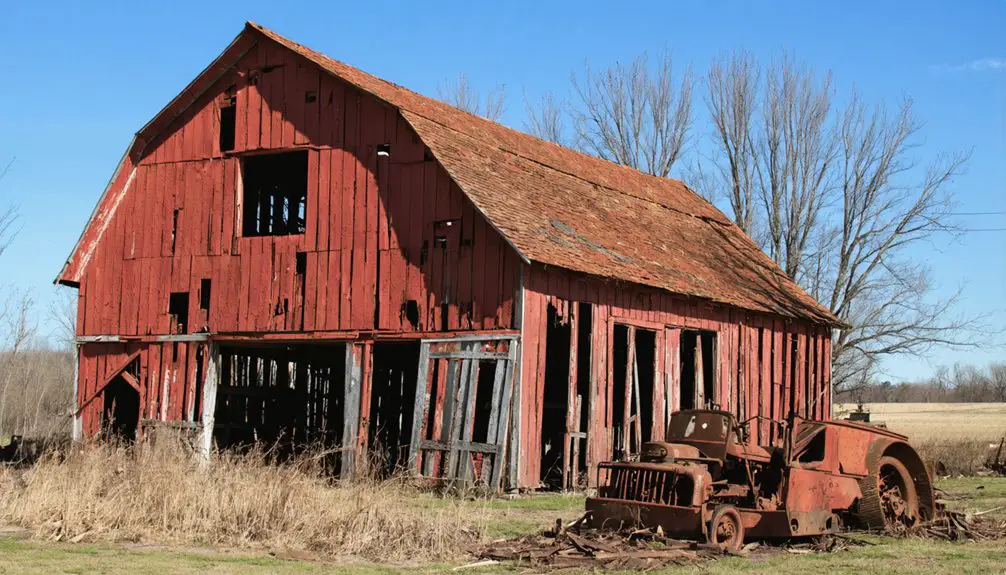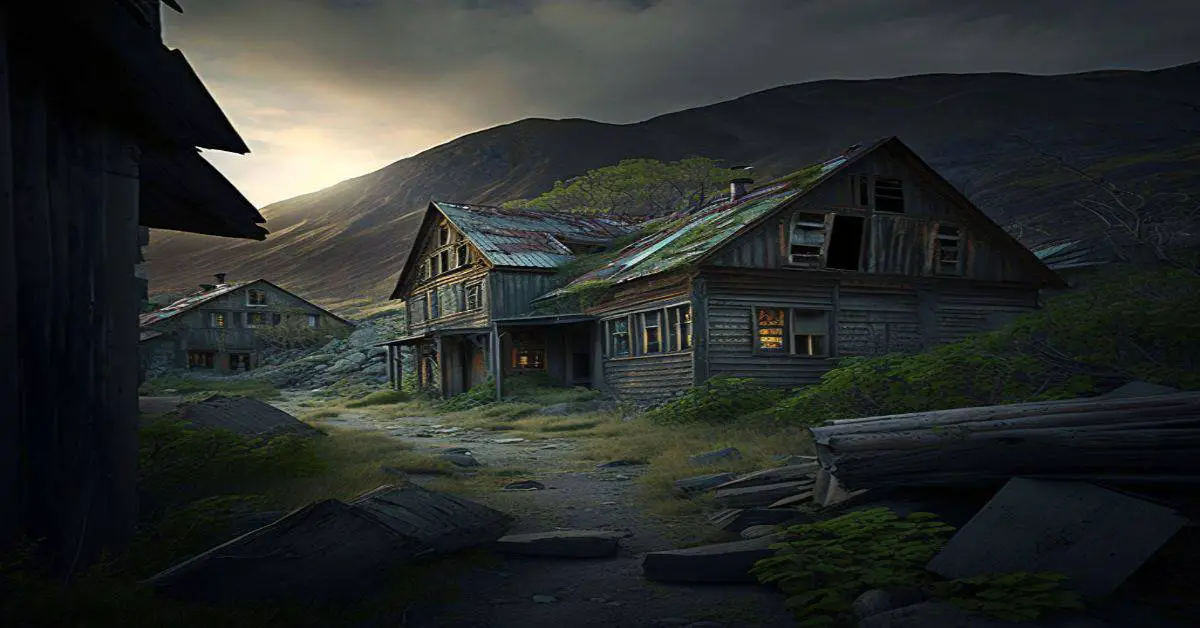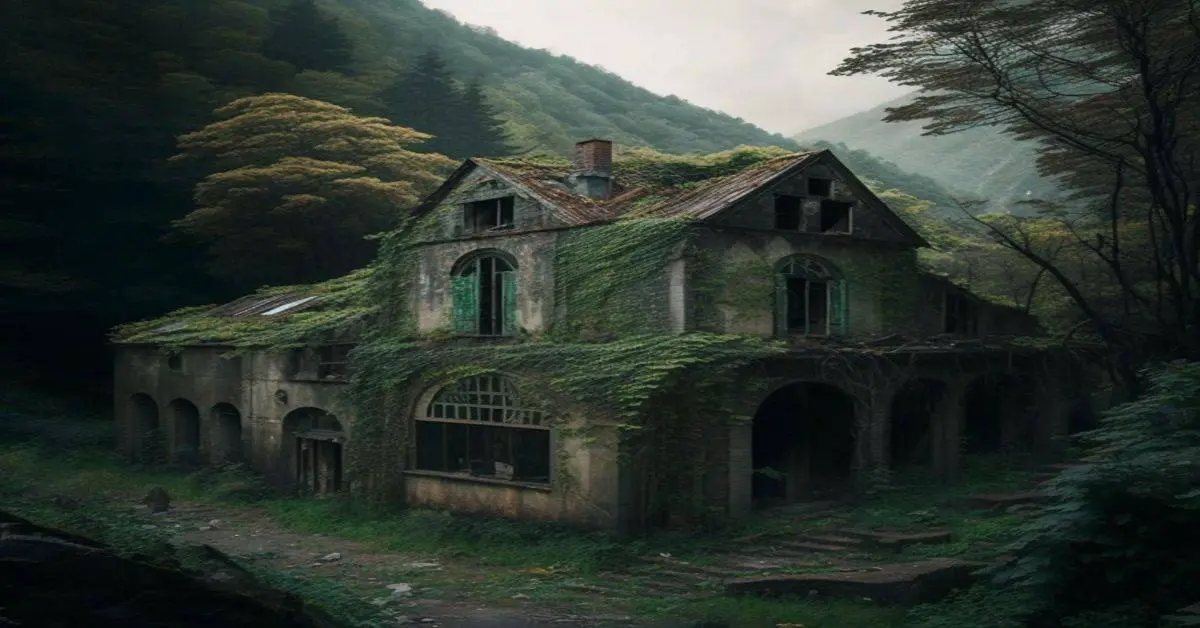If you’re exploring Michigan ghost towns, you’ll find Eckford Township‘s remnants along the former Cincinnati, Jackson and Mackinaw Railroad line. First settled in 1831, this once-bustling village emerged in 1883 when rail service connected it to Marshall and Homer. Though it thrived briefly as a timber and agricultural hub, Eckford’s fortunes declined after railroad realignment bypassed the town. Today, the Sackett schoolhouse museum preserves the stories of this vanished community.
Key Takeaways
- Eckford became a ghost town after the Cincinnati, Jackson and Mackinaw Railroad realigned its tracks, bypassing the once-thriving village center.
- The town’s decline accelerated when young residents moved to urban areas like Albion, leaving behind an aging, diminishing population.
- Agricultural mechanization and market changes made Eckford’s small-scale farming unsustainable, contributing to its economic downfall.
- Originally settled in 1831, Eckford flourished as a railroad village until transportation shifts and economic challenges led to abandonment.
- The converted Sackett schoolhouse museum now preserves artifacts and historical exhibits from Eckford’s railroad-era peak and subsequent decline.
Early Settlement and Origins of Eckford Township
The settlement of Eckford Township began on June 16, 1831, when pioneers Seeley Neal, Ashel Warner, Elijah Crane, and A. Dustin made the first land entries in the area. Neal established the township’s first log house on section 27 near Territorial Road, while Colonel John Ainsley and Erastus Kimball soon followed, settling on section 21. The land was particularly appealing with its valuable timber species that provided essential building materials.
The Michigan Central Railroad, completed in 1844, brought significant transportation development to the region. As settler experiences shaped the community’s identity, you’ll find that township formation evolved from being part of the larger Homer Township to becoming its own entity.
The area’s name changed from initial considerations of Marengo and St. Cloud to finally becoming Eckford, named after its first settler and surveyor. The rich, fertile plains and abundant wildlife drew numerous settlers from New York and Massachusetts, who valued the region’s natural resources and agricultural potential.
The Rise of a Railroad Village
When the Cincinnati, Jackson and Mackinaw Railroad arrived in 1883, it transformed Eckford from a rural crossroads into a bustling village center. The railroad expansion prompted the official platting of the village and established a crucial transportation link between Marshall and Homer.
The original settlement was established along the Detroit, Toledo & Milwaukee line, which helped drive early development.
Along with other local businesses, John Taylor initiated the village’s development through official platting.
You’d find a modest train station serving both passengers and freight, while merchants set up shops nearby to serve railroad workers and travelers.
Key developments during this period of village growth included:
- A Michigan Central Railroad agent operating daily shifts by 1917
- Commercial outlets selling gasoline, automobiles, and ice cream near the rail stop
- Enhanced shipping capabilities for local agricultural and timber products
The railroad’s presence created new economic opportunities, connecting Eckford to regional markets and forever changing this once-isolated farming community.
Archaeological Heritage and Ancient Mounds
Unlike many historic sites in Michigan’s Upper Peninsula, Eckford’s archaeological record reveals limited evidence of ancient Native American settlements or burial mounds.
While you won’t find documented indigenous mound significance within the ghost town’s boundaries, the broader region tells a different story.
The Upper Peninsula’s archaeological heritage, particularly in the Keweenaw Peninsula, features rich evidence of indigenous practices through copper culture sites and burial grounds.
The area’s copper mining heritage produced ten times more wealth than the California Gold Rush.
You’ll discover that many Michigan ghost towns emerged from resource extraction industries that often overlapped with Native American sites.
Though Eckford itself doesn’t preserve ancient mounds, nearby museums showcase artifacts from the region’s prehistoric copper mining and indigenous settlements.
In fact, the area experienced America’s first mining boom in 1844, generating more wealth than the California gold rush.
Local preservation efforts focus primarily on Eckford’s railroad and settler history rather than ancient archaeological features.
Preserving Local History Through Museums and Monuments
Preserving Eckford’s heritage centers on its converted Sackett schoolhouse museum, which serves as the primary repository for local artifacts and historical exhibits since its relocation to the village center.
Community engagement drives the museum’s success, with local residents and historians maintaining collections that tell the story of the village’s development. Similar to the monthly seminars offered at military museums, educational events help connect residents to their local history.
Dedicated local volunteers preserve Eckford’s heritage through diligent curation of artifacts that chronicle our community’s evolving story.
At the heart of Eckford’s main intersection, you’ll find a historical monument erected in 1980 that commemorates the village’s founding and railroad-driven growth.
The monument, along with village boundary markers, reinforces Eckford’s enduring presence despite ghost town concerns.
- Historical artifacts showcase early settlement life and railroad expansion
- Interactive exhibits feature oral histories from longtime residents
- Educational programs connect visitors with Eckford’s past through guided tours and interpretive materials
Economic Shifts and the Path to Ghost Town Status
Despite its promising start as a 19th-century agricultural hub, Eckford’s path to ghost town status emerged through a complex web of economic shifts.
You’ll find that the village’s economic resilience was tested when the Cincinnati, Jackson and Mackinaw Railroad’s realignment bypassed the town, severely impacting local commerce. The community’s attempts at adaptation couldn’t overcome the mounting challenges of agricultural mechanization and market changes. Similar to the immigrant families who once populated mining towns, workers gradually left in search of better opportunities. Today, the quiet atmosphere stands in stark contrast to its once-bustling past.
Unlike other Michigan ghost towns that vanished due to resource depletion, Eckford’s decline was gradual. The town’s light loam farmland couldn’t sustain small-scale farming as agribusiness took over.
Without major industries to provide alternative employment, younger residents migrated to urban centers like Albion. This exodus triggered a domino effect – reducing the tax base, diminishing local services, and ultimately transforming this once-vibrant community into a ghost town.
Frequently Asked Questions
Are There Any Remaining Original Buildings Still Standing in Eckford Today?
Ever wonder what remains of the past? You won’t find any confirmed original structures standing in this location today, though its historical significance lives on through scattered remnants and documentation of early settlement.
What Is the Current Population of Eckford’s Ghost Town Area?
You won’t find separate population statistics for the ghost town area specifically. While the township has current demographics of 1,298 residents, historical significance suggests the abandoned section itself has virtually no inhabitants.
Can Visitors Freely Explore the Archaeological Mounds in Eckford?
You can’t freely explore the mounds due to strict visitor regulations and mound preservation laws. They’re located on private property and require proper permits or guided tours for legal access.
What Are the Operating Hours of Bruce Rapp’s Local Museum?
You’ll need to contact Bruce Rapp directly for museum hours since this local history collection is privately maintained. There aren’t set public hours – visits are typically arranged by personal appointment.
Does Anyone Still Live Within the Original Village Limits?
Based on verified Eckford history and village demographics, you won’t find any current residents within the original village limits. The area stands completely abandoned, reflecting its authenticated ghost town status.
References
- https://kids.kiddle.co/List_of_ghost_towns_in_Michigan
- http://genealogytrails.com/mich/calhoun/history_townships2.html
- https://www.youtube.com/watch?v=6wxzbfrg_Qo
- https://www.albionmich.com/history/histor_notebook/011209.shtml
- https://99wfmk.com/eckford-michigan/
- http://genealogytrails.com/mich/calhoun/history_townships4.html
- https://albiontwpmi.gov/history/
- https://www.eckfordtownshipmi.gov/history
- https://www.michiganrailroads.com/stations-locations/77-calhoun-county-13/576-eckford-mi
- https://www.themillerfoundation.com/wp-content/uploads/2017/08/95683897-Tales-of-Battle-Creek.pdf


